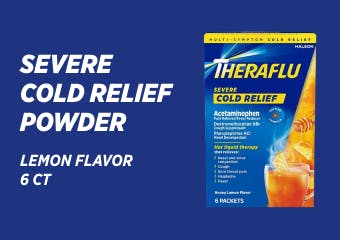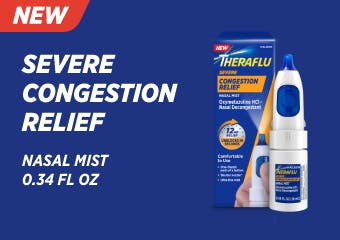What causes a cold?
More than 200 different viruses are known to cause the symptoms of the common cold. The virus groups that contain cold-causing viruses include rhinovirus, coronavirus, adenovirus, and respiratory syncytial virus.3 The majority of adult colds are caused by rhinoviruses,1 which has at least 100 distinct virus types in its group.3
Despite popular belief, a cold is not caused by cold weather or getting wet.4 While colds are more common during the cold season, from early fall to late winter, this is a result of other factors, such as people staying inside more often where viruses are more easily spread.4
The common cold is easily spread through airborne droplets that are coughed or sneezed into the air and inhaled.4 You can also catch a cold from touching a surface, such as a doorknob, that a sick person has touched.4
How do you know if you have a cold?
When you’re feeling under the weather, it might be difficult to determine what is causing you to feel sick. Colds share some symptoms with other illnesses, such as the flu, and can even be mistaken for allergies.
Although it’s easy to mistake a bad cold for the flu, there are differences between them. Colds are generally less severe and don’t come on as suddenly as the flu. Also, certain symptoms are likely to be more prominent. People with colds are more likely to have a runny or stuffy nose, while fever is more common to the flu.5
What are the symptoms of a cold?
Colds usually start 2 to 3 days after the virus enters the body and symptoms last from several days to several weeks.4 Common cold symptoms include:1
- Runny nose
- Nasal congestion
- Scratchy or sore throat
- Sneezing
- Cough
- Low-grade fever
- Minor body aches or a mild headache
Is a cold serious?
A cold is usually harmless, although it might not feel that way. While a cold can make you feel miserable, fortunately, it should go away on its own after about a week or two.1 Be considerate to others and wash your hands often so you don’t spread germs. If possible, you should stay home to avoid getting others sick.
Although the common cold is not a serious illness, cold symptoms can sometimes indicate other medical conditions. Consult your healthcare provider for a diagnosis if your symptoms are severe or long-lasting.
Colds can also sometimes lead to secondary infections, such as sinus infections, that may require further treatment.4 If you have a cold along with a high fever or severe sinus pain, contact your healthcare provider.4
What you can do to ease the symptoms
There is no cure for a cold, but that doesn’t mean you can’t find some symptom relief while sick. Although colds can sometimes be unavoidable, feeling miserable isn’t inevitable. Here are a few things you can do to lessen symptoms and make yourself more comfortable.4
- Rest. Take it easy and stay home if you can. You’ll feel better and prevent others from getting sick.
- Stay hydrated. Drinking plenty of fluids is important to avoid dehydration and promote healing. Avoid drinking alcohol while sick, as alcoholic beverages can worsen symptoms.
- Soothe a sore throat. Gargling with warm salt water is an easy home remedy for relieving a painful sore throat.
- Use a humidifier. Using a clean humidifier or cool mist vaporizer can help sore throats and sinus congestion. Limit smoking. If you smoke, stop or cut back while you have a cold. Smoking your throat and symptoms may last longer if you smoke.1
- Try out Theraflu.* Theraflu products ease a variety of cold symptoms, including sore throat, and cough. Pour a warm cup of Theraflu Multi-Symptom Severe Cold Hot Liquid Powder and find powerful symptom relief.
Although you won’t always be able to avoid catching a cold, knowing what causes the virus to spread can help prevent getting sick. Luckily, even if are sick with a cold, there’s plenty of ways to ease your symptoms and recover quicker.* Use only as directed.





